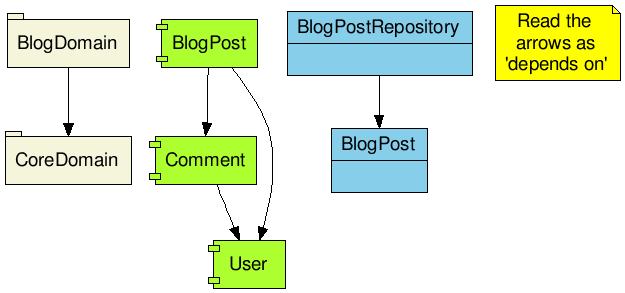Code Folder Structure
By
Mathias Verraes
Published on 22 October 2011
By
Mathias Verraes
Published on 22 October 2011
All code bases I ever read or worked with, share a similar folder structure:
The ones where the developer has read Domain Driven Design, or is using Doctrine2 or Hibernate, usually have a better focus on the domain model:
The philosophy of these folder structures is usually inspired by the frameworks they use. After all, if your framework is organized like this, it must be a best practice, right? It does make really good sense for a framework to be organized in packages [modules, components, …] like this.
For your application, it’s a missed opportunity. You are not communicating the role each class has in relation to others, or the dependencies it has. A BlogPostRepository and a CommentRepository have no direct relation to each other, apart from the fact that they are both Repositories. However, a BlogPostRepository has a very tight dependency on BlogPost.
This makes it a lot easier to communicate bounded contexts, and to illustrate dependencies. For example, the BlogDomain depends on the CoreDomain. On a smaller scale, the BlogPost package depends on the Comment package. Zooming in even further, BlogPostRepository depends on BlogPost.

In other words: A BlogPost and a Comment know about their author. A BlogPost has zero or more Comments, but the Comments are not aware that they belong to BlogPost. A BlogPostRepository manages BlogPost entities, but those entities have no idea that they are being managed.
Obviously the whole example is too simple, as examples usually are. The point is that, to keep code clean, it’s important to think hard about coupling between elements. A folder structure aides to delineate depedencies. Close proximity in the tree suggests closer coupling. Documentation can further help to explain the direction of the coupling. We may just as well decide that Comments do know about the BlogPost they belong too, but that should be a conscious decision.
Update August 18, 2014: I still agree with the general idea of this post, which is to group files or classes according to their cohesion in the domain and the model, as opposed to their underlying patterns or infrastructure. However, I wouldn’t use names like BlogDomain and CoreDomain anymore. Whatever your core domain is, it might change in the future. Businesses evolve. Authentication might be a better name. I also wouldn’t use the suffix “Domain” anymore. And finally, I would attempt to reduce the coupling between blogs and authentication, for example by only sharing a small set of Domain Events.
Follow me on
Mastodon,
Bluesky,
LinkedIn, or use the
Atom feed for updates.
Support my writing by buying my book Design and Reality.